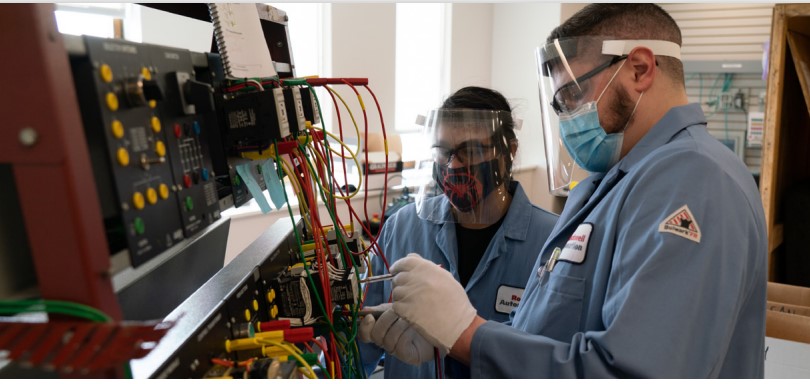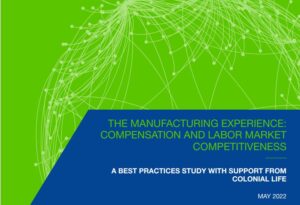New Report from NAM Outlines What Manufacturers Must Do to Retain Skilled Workers

By Chad Moutray, Chief Economist, National Association of Manufacturers (NAM)
In this excerpt from NAM’s recently published report, ‘The Manufacturing Experience: Compensation and Labor Market Competitiveness,’ Chad Moutray examines the data and analyzes what U.S. Manufacturers have done to address the crisis in finding skilled manufacturing workers. It’s not just about compensation.

Chad Moutray
Manufacturers are facing numerous interrelated challenges, many that are unlike anything confronted in recent history. While overall manufacturing activity and growth in the sector has proven to be resilient, companies have struggled to meet demand, particularly as firms have grappled with supply chain bottlenecks, persistent COVID-19 outbreaks, soaring input costs and workforce challenges. More recently, the Russian invasion of Ukraine has further exacerbated supply chain and pricing pressures, adding new risks to the economic outlook. Nonetheless, the manufacturing sector has continued to reflect relative strength.
The NAM Manufacturers’ Outlook Survey for the first quarter of 2022, for instance, found that nearly 89% of respondents felt positive about growth at their companies, an elevated reading that has not changed much over the past five quarters. In addition, manufacturing production has rebounded strongly after plummeting sharply in spring 2020 at the beginning of the COVID-19 pandemic, with output in the sector now 2.9% above the level in February 2020. Likewise, manufacturing employment increased by 365,000 in 2021, the biggest annual increase since 1994, with 174,000 workers added already through the first four months of 2022. Data does suggest that manufacturing employment is on track to return to pre-pandemic levels by the third quarter of 2022, which is encouraging. However, there were 860,000 manufacturing job openings in March, and over the past 12 months, monthly job openings in the sector have averaged nearly 865,000, including the record 943,000 in July. The number of nonfarm business job openings also remain not far from all-time highs. Indeed, there continue to be more job openings in the economy than those who are actively looking for work. In fact, for every 100 job openings in the U.S. economy, there are just 51.5 unemployed workers to potentially fill those roles. Moreover, total quits in the manufacturing sector rose from 345,000 in February to 360,000 in March, a new record. That translated into 2.8% of the manufacturing workforce and continues a trend of very significant “churn” in the labor market, exacerbating the workforce difficulties that companies are experiencing.
The severe labor shortages that companies are experiencing coincide with a very tight labor market, and the result has been sharply higher wage pressures. In the first quarter Manufacturers’ Outlook Survey, respondents anticipate employee wages to rise 3.9% over the next 12 months, the fastest rate in the survey’s history. In addition, in the latest employment data, average hourly earnings of production and nonsupervisory workers in manufacturing rose 0.3% to $24.78 in March, up 5.5% from one year ago and just shy of the fastest wage growth since August 1982. Despite these sizable wage increases, the labor force participation rate remains below pre-pandemic levels, at 62.2% in April, down from 63.4% in February 2020. New research suggests that the labor force has 3.5 million workers today relative to the pre-pandemic trend, and there is expectation that many Americans might remain on the sidelines of the labor market.

Key Findings
- Manufacturers continue to cite the inability of attracting and retaining a quality workforce as a top concern—a problem exacerbated by the tight labor market.
- In local markets, there is intense competition for employees from other manufacturers, larger companies, distribution centers and service-sector companies, many of whom have also increased compensation substantially in light of the worker shortage.
- Roughly 93% of respondents had unfilled positions within their companies for which they were struggling to find qualified applicants, and 89.5% said that they have increased compensation—including wages, salaries and benefits—to remain competitive in their pursuit and retention of employees.
- Manufacturing executives have increased wages and salaries significantly to remain competitive, and many of them had done so several times in the past year or two, with intentions of still large raises this year as well.
- Roughly 73% of manufacturers felt that increased compensation had helped keep their company competitive in their ability to recruit and retain employees.
- While base hourly wages and salaries were cited as most important for attraction and retention, other benefits were also important, including health insurance benefits, bonuses and/or additional income opportunities, paid vacation leave, contributions to a 401(k) or retirement plan, paid sick leave, flexible work hours and dental and vision insurance benefits.
- Sign-on bonuses for new employees ranked higher than accident or disability insurance benefits, life insurance benefits or flexible spending accounts (each of which are common and relatively popular). That speaks to the need for some companies to offer sign-on bonuses in a tight labor market—something that many of the interviewees said that they had never had to do before.
- Roughly 59% of those completing the survey said that increased worker flexibility had helped to attract and retain employees, with nearly one-third uncertain.
- The company’s culture and “being cared for” are important differentiators for manufacturers in the competition for talent. This includes frequent and effective communication (including “being heard”), but training and upskilling, the emphasis on health and safety and drives for more inclusivity can also be helpful in making employees “sticky,” helping with retention.













